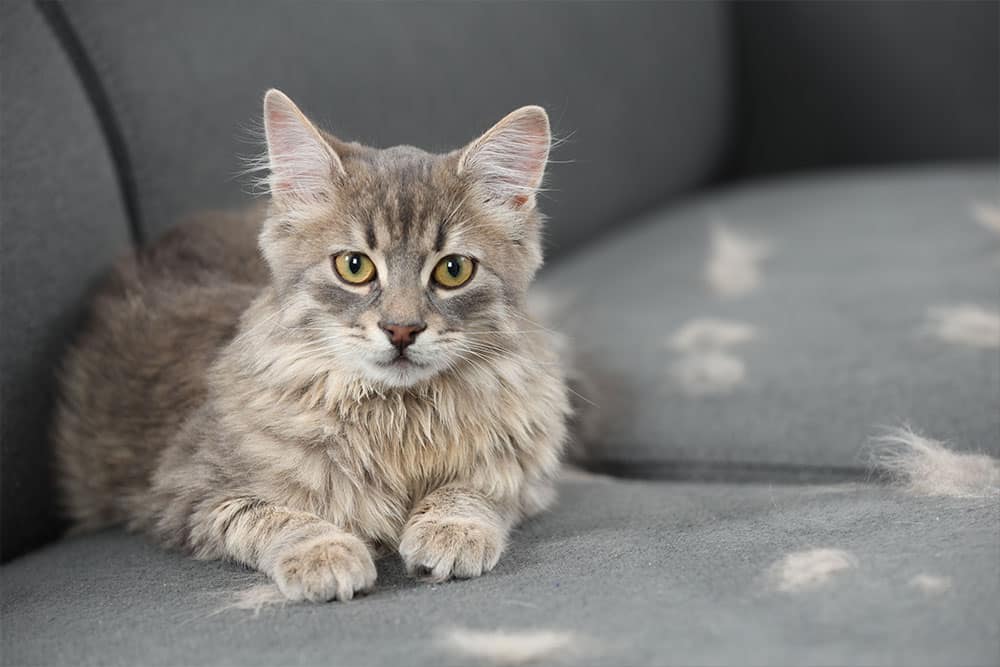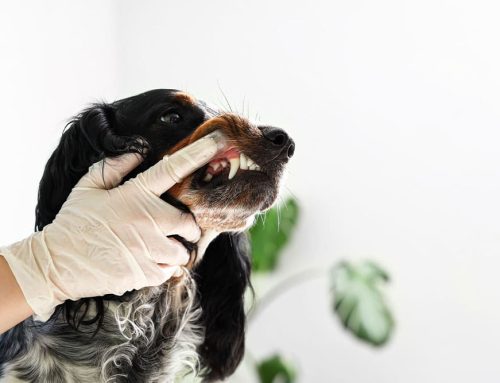Decoding Hair Loss in Pets: From Allergies to Hormones
If your pet’s once-luxurious coat is thinning or bald patches are beginning to appear, it’s time to look beneath the surface. Hair loss, also known as alopecia, can result from allergies, infections, parasites, stress, or even hormonal imbalance. The key is to uncover why it’s happening and address the problem at its source.
At MountainView Veterinary Hospital in Denville, NJ, our team blends advanced diagnostic medicine with a compassionate, family-oriented approach to care. As a Certified Feline Friendly practice, we understand how to handle even the most anxious pets gently and respectfully. From medical management to integrative therapies like acupuncture, laser therapy, and herbal treatments, we provide a complete care path that restores your pet’s comfort, and their coat.
What Causes Alopecia in Dogs and Cats?
Hair loss (alopecia) is a broad term describing partial or total fur loss. While some shedding is normal, bald spots, patchy fur, or persistent scratching often indicate a deeper issue. Alopecia isn’t a disease itself but a sign that something else is happening inside your pet’s body or environment.
The pattern, texture, and presence of other symptoms, such as itching or redness, help veterinarians determine the likely cause. At MountainView, our experienced team uses these clues along with diagnostic testing to pinpoint the problem quickly and accurately.
Common Causes of Hair Loss in Pets
Allergies: The Top Culprit Behind Itchy Skin in Pets
Allergies are among the most common causes of hair loss and discomfort. Dogs and cats can react to pollen, dust mites, mold, foods, or even flea saliva. When the immune system overreacts, inflammation and itching follow, leading to scratching, licking, and bald spots.
General pet allergies vary, often causing hot spots, while flea allergies can cause itching near the tail base and back legs. Even one flea bite can set off severe irritation in sensitive pets.
The importance of year-round parasite prevention for pets can’t be overstated. Consistent prevention reduces flare-ups and keeps skin healthy. Our veterinarians also offer allergy testing, prescription diets, and long-term management strategies for persistent cases.
Parasites and Skin Infections in Pets
External parasites cause hair loss by irritating the skin or damaging hair follicles directly. Fleas are the most common, but mites, lice, and fungal infections like ringworm can produce similar patterns of alopecia.
Spotting and treating mites in dogs is essential, as these microscopic parasites burrow into or live on the skin. Demodex mites cause patchy hair loss, often around the face and paws, while Sarcoptes mites cause intense itching and crusting.
Ringworm, a fungal infection, forms circular bald spots with red, scaly edges and can spread to humans. That’s why early diagnosis is so important.
At MountainView, our diagnostic services include in-house cytology, fungal cultures, and skin scrapings. These quick, painless tests help us identify the exact cause and begin treatment immediately, often before the condition worsens.
Hormonal and Endocrine Disorders in Pets
Internal hormone imbalances frequently cause gradual, symmetrical hair loss that isn’t itchy or painful. These changes may go unnoticed at first, but over time, coat texture and color can shift dramatically.
Hypothyroidism in dogs occurs when the thyroid gland doesn’t produce enough hormones, slowing metabolism. Affected dogs often gain weight, become lethargic, and develop dry, thinning coats.
In contrast, Cushing’s disease in dogs stems from excess cortisol production, causing a pot-bellied appearance, fragile skin, and hair loss along the sides of the body.
The importance of blood work for your dog is crucial. Routine lab testing can reveal hormone imbalances long before symptoms become obvious. Cats may also experience thyroid-related changes, particularly hyperthyroidism, which can lead to weight loss and unkempt coats.
Breed-Related and Genetic Factors in Pets
Some breeds are naturally prone to certain forms of alopecia. Color dilution alopecia in dogs affects those with diluted coat colors, like blue or silver, while canine flank alopecia causes seasonal bald patches that grow back cyclically. Although genetic conditions can’t be cured, we can help manage them through supportive skin care, nutrition, and light therapy to maintain coat health.
Stress, Anxiety, and Overgrooming in Pets
Pets, especially cats, often express emotional distress through overgrooming. Known as psychogenic alopecia, this behavior leads to smooth bald patches without redness or irritation. Feline life stressors, such as environmental changes, new pets, or loud noises, can all play a role.
Dogs may show similar symptoms, licking or chewing at one spot repetitively due to stress. We approach these cases holistically, using behavioral strategies, pheromone therapy, herbal calming support, and when needed, anti-anxiety medication. Because our doctors are trained in acupuncture and alternative medicine, we can also offer integrative therapies to reduce chronic stress naturally.
Nutrition and Grooming Habits in Pets
Healthy coats start with proper nutrition. Diets lacking essential fatty acids or high-quality proteins lead to dull, brittle hair. Overbathing or using harsh shampoos strips the coat’s natural oils, making hair more fragile.
Grooming can also help improve a pet’s coat and skin. Brushing improves circulation, removes debris, and keeps the coat glossy. During exams, we provide personalized grooming and nutrition advice, including herbal or omega-rich supplements when appropriate.
Diagnosing the Cause of Hair Loss in Pets
Every case of alopecia is unique, and pinpointing the cause requires a systematic approach. At MountainView, diagnosis typically includes:
- Comprehensive physical exam noting hair loss pattern, color, and texture
- Skin scrapings to check for mites or other parasites
- Cytology and fungal cultures to identify infections
- Bloodwork for thyroid, adrenal, or metabolic diseases
- Allergy testing or diet trials to evaluate sensitivities
Our full-service hospital offers comprehensive diagnostics to determine the cause of your pet’s hairloss. These tools give us a clearer picture of your pet’s internal balance, helping us address root causes rather than just symptoms.
Treatment Options for Hair Loss in Pets
Because hair loss can stem from so many different sources, treatment is highly individualized.
- Allergies: Managed through antihistamines, medicated shampoos, supplements, and immunotherapy.
- Parasites: Eliminated with prescription preventives and environmental cleaning.
- Hormonal disorders: Corrected through medication, hormone therapy, and regular monitoring.
- Infections: Treated with antibiotics or antifungal medications.
- Stress or anxiety: Addressed through behavior modification, environmental enrichment, or calming therapies.
- Nutritional deficiencies: Rebalanced through diet improvement, herbal therapy, or omega supplementation.
We often combine Western medicine with integrative approaches like laser therapy to reduce inflammation, acupuncture to boost healing, and PEMF therapy to improve circulation and cellular repair. These holistic modalities complement medical treatment, accelerating recovery and supporting long-term wellness.
Preventing Future Hair Loss in Pets
Prevention starts with proactive care. Here’s how to keep your pet’s coat healthy and strong:
- Year-round parasite prevention for fleas, ticks, and mites
- High-quality nutrition tailored to age and health status
- Regular grooming and coat checks to detect problems early
- Routine wellness exams to establish health baselines and monitor changes
Our wellness visits include diagnostic screenings such as thyroid panels, heartworm tests, and fecal checks to identify early disease. Routine wellness care promotes pet health by catching subtle changes before they progress.

Restoring Comfort, Confidence, and a Healthy Coat
Most cases of alopecia improve significantly once the cause is identified and treated. Whether your pet’s hair loss stems from allergies, parasites, stress, or internal disease, a personalized care plan makes all the difference.
If you’ve noticed your pet’s coat changing, don’t wait for symptoms to worsen. Schedule an appointment with our experienced team at MountainView Veterinary Hospital. For sudden or severe cases, our 24/7 emergency triage service connects you with a veterinarian any time of day or night.
Our mission is simple: to blend compassionate care with exceptional medicine, because at MountainView, your pet’s health and happiness are always our top priorities.









Leave A Comment